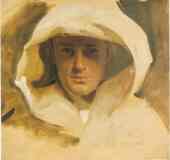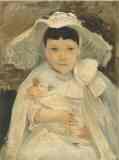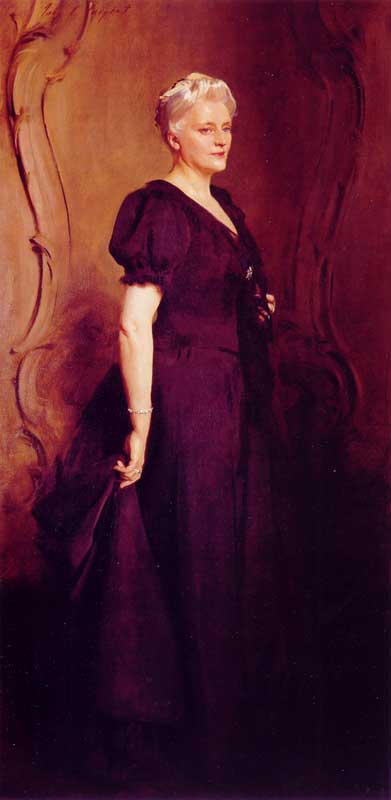Mrs.
Frederick William
Roller
(nee Eva Eyton)
John Singer
Sargent -- American
painter
1895
Frye Art
Museum, Seattle,
Washington
Oil on canvas
223.52 x
113.03 cm
(88 x 44 1/2 in)
Inscribed ur:
John S. Sargent
Jpg: Frye
Art Museum
From: Michael
& Susan Roller
(r ol
lers@ukgateway.net)
Date: Thursday, March
4, 2004
As a quick
introduction to the family
relationship with Sargent, as we understand it, Mrs F W Roller [nee Eva
Eyton]. Frederick William Roller himself [her husband] was a
German
immigrant to the UK and was naturalised in 1857. He was an import
merchant - I think somebody he knew introduced him to Sargent or some
such,
but will check this out and get back to you. His father (a
German)
was painted by some none too well known German artist and we still have
that picture in the family (not me, sadly!) Mrs FWR was painted by a
number
of relatively well known artists besides Sargent, including Dicksee and
Sir Francis Grant. We are trying to track down those pictures,
but
without much success.
My wife recently
spent a long time
tracking down the portrait of Mrs FWR by Sargent - George's son (or his
wife) sold it to A British museum in 1949 and from there it found its
way
to the Frye Art Museum.
Do you know what
private collections
the
Netty Huxley / George
Roller/ Madge
Rolland portraits are in?
That's enough for
now - more later
Saturday, March
13, 2004
Frederick &
Eva’s children
There were 6
children total:
George Conrad (1856
– 1941)

Portrait
of Major George Conrad Roller
c
1892
George was an
artist himself and
had several pictures exhibited in the Royal Academy in London (one of
his
works is in a museum near London and he did a portrait of his brother
William
which is still on display in one of London's best known cricket grounds
- William was a well known cricketer.
I have a copy of
his obituary from
the Glasgow Herald in 1941 which describes George as a “lifelong friend
of Sargent” and another picture which shows him restoring a Sargent –
you
would probably know which one! It would not scan or fax, but I
can
mail you a copy if you send me an address.
He was a Major in
the Territorial
Army (which is the sort of Reserve Army) up until 1900 when he saw
active
service in the Boer War (I do not think any of his siblings were in the
Army) and won the DCM in the Boer War – he must have been quite old for
a soldier then, as it was around the turn of the century. It
seems
as if he was even involved in some military capacity in the First World
War, when he was in his 60s.
The obituary says
he was well known
as an artist and illustrator in the newspapers and magazines of the
1870s.
It goes on to say that “ at the age of 80 he undertook the restoration
of a number of Old Masters. This was a task of which he had
considerable
experience some years before, when he was called in to repair pictures
slashed by the militant suffragettes”.
(Editor's
Note -- Sargent's
painting of Henry James was slashed by a suffragette during a show at
the
Royal Academy in 1914. The article in The
London Times, May 5, describes the event)
A number of
George's sketches are
preserved in the Burberry archives. (Burberry the luxury goods
department
store in London -- then a "gentleman's outfitters", now a luxury goods
store & brand).
I think the
likeliest reason for
Sargent painting his mother would be an introduction via George – they
were born the same year and very probably both trying to make their way
as artists in London in the 1870s. I also understand that George
was a friend of the Harrison
family – I see several pictures on the site of people called
Harrison,
but it is a common name. The ones he was friends with were
stockbrokers
(discussed at www.hichens.com)
William Eyton
(1858 – 1949)
My great
grandfather. Famous
cricketer (portrait of him by elder brother George hangs in a famous
London
cricket ground today).
Frederick Albert
Don’t know too much
about him, but
he was a lawyer. I do know his grandson (who is still alive and
who
I “discovered” by accident as another Roller a couple of years
ago.
He is the one with the portrait of Georg Jacob.
John Harold
He married Netty
Huxley, who was
the daughter of T H Huxley (who was pretty famous as a biologist and
general
polymath, Google will have plenty about him).

Nettie
Huxley
1888
He, John Harold,
was not ever a soldier. I
will write out what
I have about him copied verbatim from my aunt’s notes,
based on conversations with her father (WER’s son) in the early 1960s.
“A charming and
kind person with
a great sense of humour. After Westminster (his school) went to
the
School of Mines, London and then to California as a mining
engineer.
Contracted TB (Tuberculosis) and had to give up mining. Took up
photography
professionally (took the photo of Sargent’s portrait of his
mother).
During the 1914/18 war took “before and after” photos for a dental
surgeon
who repaired the smashed jaws of soldiers wounded in battle.
Spent
many winters in Switzerland. Netty and he had one daughter, Madge
(this is Marion) who studied singing in Switzerland during the 1914/18
War.

Madge
Roller
1902
There she
contracted liaison with
(wonderful euphemism for “had an affair with”!) Gigli (I believe a
famous
opera singer at the time) who refused to marry her.
Madge thereafter
took the surname
Rolland ( I presume this was to fool people into thinking she had been
married, to explain away the child with Gigli). Madge’s child,
who
was called Barbara married a Czech eye surgeon.”
(Fri, 15 Oct 2004: I
had an interesting e-mail a while ago from someone called
Tony Hirtenstein, who is Netty Huxley's great
grandson!)
Charles Trevor
Not much known
about him. Married,
had two daughters and died young.
Beatrice Eva
Not much known
about her – married
her first cousin, apparently to the family’s great disgust!
The Rollers
History
The furthest back
we go for the Roller
name in terms of information is to Johann David Roller, a cloth
manufacturer
living in Germany in the mid eighteenth century.
Johann David had a
son, Georg Jacob
who was born in 1774. He was a teacher of what we would call
today
special needs children and played a part in inventing “deaf and dumb”
language.
[One of the few surviving Rollers from this branch – there are around
12
in total with the surname Roller – has a portrait of him hanging in his
house]
Georg Jacob and his
wife had 10 children,
only four of whom survived into adulthood. Frederick William was
the only son of these four. He was born in 1817 and emigrated to
England in 1842 and married Eva Eyton in 1853.
Eva's family --
established Welsh
family
The Eyton family
has a lot of history
– we have a copy of a family tree that goes back to 924 – nearly 1,100
years! I have to say that it is unlikely to be totally
historically
accurate. Many families in England possess such documents.
What is clear is that the Eytons are a well known Welsh family and for
Frederick Roller to have got Eva’s father’s permission to marry her in
1853 (when he was not naturalised as a British citizen) is a sign that
he must have been doing well in his business.
What was his
business? He was
a partner in a firm of import merchants, and I have a reference that
suggests
they were importing the bark of the Chinchona tree from South America,
which was used to make quinine (which I guess would have gone into
tonic
water).
In 1857 he became
naturalised, and
I have a copy of his certificate of naturalisation. This says
that
he sought to become naturalised in order to purchase the freehold of a
house at Clapham Common (a suburb of London). This house would
have
been “The Grange” where they lived for a long time. Their eldest
child, George would have been a year old at that time, and this is
possibly
another reason he decided to become naturalised.
The Rollers and
C19 painters
I understand
Frederick & Eva
knew Millais (1829-96) as well as Sargent. Eva’s will (she died
in
1896) shows she was interested in art and proud of her portraits by
various
artists:
• William Eyton
Roller was left a
portrait of her by Sir Francis Grant (1803 – 78) (we have an image of
this)
• Frederick Albert
Roller was left
a portrait of her by Dicksee (1819-95) and a portrait of himself by Joy
• Charles Trevor
Roller was left
a portrait of himself and his sister (Beatrice) by Dicksee
It seems to me that
Frederick &
Eva must have got to know a number of reasonably prominent artists of
the
generation before Sargent’s (eg Millais, Grant, Dicksee) and perhaps
one
of that generation introduced them to Sargent? Another theory
would
have to be that their eldest son George (see above)
arranged for Sargent to paint his mother? I think the portrait
was
dated 1894, which is only 2 years before Eva’s death.
Notes:
Special thanks to
Michael &
Susan Roller, of the UK, friends
of the JSS Gallery, for sending me their family history.
|



